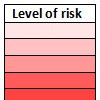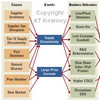 Egypt is in crisis. After Tunisia, now Egypt is rocked by a popular uprising, and the outcome of the so far peaceful protests is still uncertain. This unstable and developing political situation has brought me the perhaps perfect background for today’s book review: A Short guide to Political Risk by Robert McKellar. Every firm with a supply chain that sources globally or operates internationally is exposed to political risks that may be very different from what they are used to domestically, where political risks often limit themselves to de-regulations and re-regulations of business sectors, tax cuts or tax hikes or sudden environmental measures or security enforcements following major events or changes in government. On the international scene such and perhaps even worse changes can come abruptly and without warning, not because they cannot be foreseen, but because the firm usually lacks the tools and the knowledge it needs to anticipate and react coherently to political risks.
Egypt is in crisis. After Tunisia, now Egypt is rocked by a popular uprising, and the outcome of the so far peaceful protests is still uncertain. This unstable and developing political situation has brought me the perhaps perfect background for today’s book review: A Short guide to Political Risk by Robert McKellar. Every firm with a supply chain that sources globally or operates internationally is exposed to political risks that may be very different from what they are used to domestically, where political risks often limit themselves to de-regulations and re-regulations of business sectors, tax cuts or tax hikes or sudden environmental measures or security enforcements following major events or changes in government. On the international scene such and perhaps even worse changes can come abruptly and without warning, not because they cannot be foreseen, but because the firm usually lacks the tools and the knowledge it needs to anticipate and react coherently to political risks.
Political risk and supply chains
Political risk, although not absent, is not particularly well covered in the supply chain risk literature. Among others, it is mentioned in Goshal’s Global Supply Chain Risk Management, as well as in AON’s political risk map, and naturally in the Global Risk Reports by the World Economic Forum. That said, as a subject for supply chain risk research it is very rarely found, perhaps because there are so many more imminent dangers to supply chains than the political risk that more often than not lurks in the background, and not in plain sight.
Considering the potential impact that the political environment has on how the firm can, may or should conducts on business operations, political risk management should be an integral part of any firm’s risk assessment process, particularly if much of its revenue stems from international business. For example, according to cio,com, the European Outsourcing Association named Egypt its 2010 outsourcing destination of the year, but recent events are likely to take their toll if the situation continues, and Internet access remains blocked. This is only one of many risk faced by companies with international ties, and this book is an essential introductory guide for firms and risk managers in how to navigate the treacherous waters that surround political risks.
Key objectives
Chapter 1 introduces the key objectives that the book addresses:
- the key political risk that companies have faced in the recent past, and current and future trends
- the concept of political risk and its constituent elements
- models and approached for assessing political risk in a specific context
- the principal options for managing political risk and suggestions for developing organizational structures
- some of the wider issues that a company needs to consider in developing its own attitude and philosophy on political risk
Political risk is a complex issue, and this book is only an introduction that illustrates the broad outlines, but nonetheless, it is an important book that focuses on operational and strategic issues that are not widely covered by other literature.
Political risk: continuity and change
Chapter 2 introduces and describes many of the risks that shape the political risk landscape and states that political risk has always been part of international business.
Some of the constantly recurring risks that have always been part of the picture are
- International tensions
- Domestic unrest
- Terrorism
- Politically connected criminality
- War
- Expropriation and contract cancellations
- Bureaucratic morass
- Ethical criticism
The last two decades have seen some significant shifts in risks:
- The rise of political Islam
- The collapse of the USSR
- Global multi-polarity after the bi-polarity of the Cold War
- Failed and failing states due to weak governance and social fragmentation
- Global asymmetric warfare where minor (terrorist) groups can significantly harm major and more powerful opponents
Finally, future trends are likely to see
- Increased ethical criticism and focus on corporate social responsibility
- Increased confusion in inter-state tensions with a wide range of potential global disputes and power centers
- Increased exposure to civil violence, unpredictable regimes, localized conflicts and civil unrest in new “hot spots”
- Increased exposure to terrorism, accelerated by the rise of Islamist extremism, failed/failing states and new capabilities in assymetric warfare
While perhaps a snapshot only, the above does serve as an excellent starting point for manoeuvring the inherently complex landscape of political risks.
Political risk: analytical variables
Chapter 3 breaks political risk into manageable subjects or factors.
Starting with the bottom-line question, “What are our political risks?” is seldom feasible, and can yield some pretty fantastic and incoherent results. Initially asking broader questions about each sub-element of political risk is more manageable, and ensures that key questions are addressed along the way without leaping to conclusions based on suppositions or a general reading of what kinds of political risk exist.
Firstly, the risks faced by a company depend to an extent on the business sector a firm competes in. Secondly, when considering political risk, it is important to look at how much risk a company is willing to bear. Thirdly, it is necessary to evaluate what assets that is at risk. Fourthly, in order to manage risk, the three main sources of political risk must be analyzed: political instability, weak governance and conflict. The fifth and final consideration for analysis is the level where the political risk resides: global, local or simply operational.
Assessing political risk
Chapter 4 describes the details and steps of how to assess political risk. This -in my opinion – is the best part of the book.
There are three stages of analysis at both the corporate and operational levels: contextual analysis, which defines the factors by which we derive the initial risk hypotheses and and interpret risk; risk analysis, which derives priority near-term issues; and scenario analysis, which examines how the risk environment might change in the future.
The contextual analysis is divided into a) a company’s risk tolerance, or how willing the firm is to subject itself to the risk incurred by exposure to unstable market environments, and b) a company’s global risk portfolio, a map that correlates the global exposure to risk across its operating environments, showing how each business operation or location is exposed to a different level of risk while possessing different strategic values.
The risk analysis has three stages: a) hypothesis generation, b) risk factor identification and c) risk assessment. Hypothesis generation examines how a company’s activities may affect political interests, by identifying stakeholders directly, and more generally, the political terrain surrounding a company’s activities. Risk factor identification identifies the potential effect of risk factors on key exposed assets; where an asset could suffer harm, a risk exists. Risk assessment involves estimating the potential impact of an identified risk, should it occur, and the probability of its occurrence, and establishes a traditional risk matrix.
The scenario analysis is a six-step process that allows the company to see what could happen and to identify possible future states and how they may or may not be relevant to the company’s interest. Mind you, so McKellar says, the more detailed or technical the approach, the more precise the results, but not necessarily the more accurate. It is perhaps better to be accurately right than precisely wrong.
Political risk management
Political risk management is more than just knowing that “bad things can happen in developing countries” and preparing for damage limitation. Political risk management, the topic of chapter 5, means enabling the fulfilment of business objectives in even high-risk political environments. In essence, being able to operate in high-risk environments means to be able to show extreme flexibility to accommodate shifting political currents. This ability is what McKellar calls resilience. Political risk management is also a strategic enabler, allowing the company to plant roots in new territories as beachheads for growth and access to lower cost inputs, perhaps even temporarily barring competitors from entering the same environment.
Political risk management needs to employ both a) near-term risk management plans focussing on avoidance, prevention and damage limitation through preparation for effective responses to a manifested risk, and b) long-term contingency plans, aligning the company posture with the emergence of a given scenario.
McKellar defines four broad categories of political risk management measures: portfolio management, adjusting individual operations such that an overall desired level of risk is achieved; security, to protect the company against physical threats and malignant relationships; relationship building, i.e. gaining politically influential supporters directly and personally or generally and publicly through corporate social responsibility; and risk transfer, by reducing the firm’s risk by sharing it with other stakeholders.
It is important to not consider the above management measures as a list of stopgaps only. Political risk must be dealt with at a strategic level, and each company needs to shape its own unique approach in the context of its business aspirations and unique corporate culture. A familiar statement, when considering what Vivek Sehgal wrote his book Supply Chain as Strategic Asset.
Conclusion
It is obvious to me after reading this book that no company can escape political risk one way or the other, not even in a seemingly stable political environment. The stakes may be lower in some places, but conversely, much higher in other places. Political risk is a business risk that should be considered along with the wide range of other business risks that accompany a firm’s business endeavours. While this book looks exclusively at political risk, many of the approaches, methods and measures are equally applicable to risk management in general. As such, the book’s value is not as limited as the title may imply and it can very well serve as a guide for general risk management.
Reference
McKellar, R. (2010) A Short Guide to Political Risk. Farnham: Gower Publishing
Author link
- linkedin.com: Robert McKellar
Publisher link
- gowerpublishing.com: A Short Guide to Political Risk
- gowerpublishing.com: A Short Guide to Political Risk (Introduction)
Buy this book
- amazon.com: A Short Guide to Political Risk
Related posts
- husdal.com: Book review – Customs Risk
- husdal.com: Book review – Reputation Risk
- husdal.com: Book review – Procurement Risk












